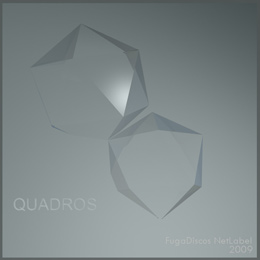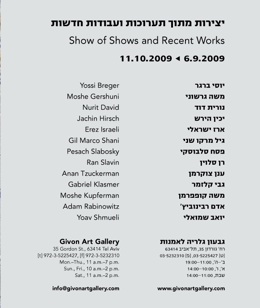
Vitor Joaquim, José Luis Ferreira, Ricardo Ferreira, Miguel Cardoso and the Orchestrautopica perform tomorrow night at Culturgest, Lisboa.
“Erotikon†reviewed by OndaRock

Dopo che il precedente “Musicamorosa” ne aveva rivelato la raffinatezza delle texture ambientali, il portoghese Jorge Mantas, aka The Beautiful Schizophonic, torna con il suo secondo lavoro ufficiale sulla lunga (anzi, lunghissima) distanza, confezionando oltre un’ora di musica nella quale concede libero sfogo alle sue complesse elucubrazioni sonore, trovando questa volta ulteriore supporto nella partecipazione di alcuni collaboratori che ne ampliano in vario modo i punti cardinali.
Riposta nel cassetto l’ispirazione proustiana sottesa a “Musicamorosa”, sembra più difficile individuare un filo conduttore concettuale nel nuovo “Erotikon”, al di là dei connotati espliciti del titolo e della copertina, tuttavia non facilmente associabili a un contenuto musicale dai tratti pur intensi e suadenti.
Il lavoro ripresenta da subito drone impalpabili e modulazioni circolari in loop levigati, sfiorando morbidi contorni da ambient orchestrale e ribadendo la naturale vocazione cinematica di molte composizioni di Mantas; l’artista portoghese eccelle tuttavia ancora una volta nel conferire a questi elementi di base una straordinaria varietà , in grado di rifuggire alla radice la sensazione di eccessiva piattezza spesso connaturata a produzioni del genere.
Sul costante abbraccio elettronico di fondo, Mantas innesta instancabile una miriade di increspature moderatamente rumoriste, coltri ambientali ondeggianti, field recordings e ipnotiche derive psych, che insieme contribuiscono a colorare con tinte vivissime i flutti pulsanti originati da drone di rara eleganza e altrettanto preziosa delicatezza emotiva.
Il personale spettro musicale di Mantas oscilla infatti tra sonorità placide e incantate, come quelle dell’iniziale “Furla” e di “Alba”, ricorrenti emersioni distorsive e irregolarità stranianti espresse nella liquida ipnosi di “Blumarine” e nelle sfumature notturne di “Nocturnosque”, quest’ultima impreziosita dalla chitarra di Clayton McEvoy, da poco autore di un pregevole debutto a nome Sleeping Me. In un susseguirsi di voci, field recordings, frequenze cosmiche filtrate e lievemente distorte, scorrono istantanee cangianti e cortometraggi dalla durata più considerevole: già i due brani introduttivi ribadiscono l’attitudine di Mantas a misurarsi con composizioni lunghe e complesse, ma sono i due viaggi di un quarto d’ora “Pollen” e soprattutto “Aliénor d’Aquitaine” a rivelare l’ampiezza di respiro di composizioni che si dipanano in una serie ininterrotta di piccoli crescendo che affiorano tra brume sospese in un altrove spazio-temporale, giocando a rimbalzo tra soundscaping dilatati e continui esperimenti di persistenza.
Menzione a sé merita invece “Alba”, non solo poiché contiene un estratto da un nastro del 1860 – che si afferma essere la prima registrazione di una voce umana esistente – ma in particolare per la partecipazione del giapponese Yui Onodera, le cristalline note del cui piano fungono da contraltare a fremiti e distorsioni di fondo, dando luogo a un perfetto connubio di elementi e a quella straordinaria policromia tonale che rappresenta una delle migliori qualità dell’artista portoghese.
Fosche e spettrali ma lontane dal ricadere in cliché dark-ambient, lievi e romantiche come le piéce austere e impalpabili di Eluvium ma pervase da una frenetica ricerca sonora degna di icone quali Labradford e Stars Of The Lid, le composizioni di Mantas delineano una concezione della musica ambientale vitalissima e in continuo divenire, che lo attesta a pieno merito tra i più interessanti interpreti attuali di un genere raramente così vibrante e in questo caso tale da essere ricondotto, appunto, a un immaginario di intensa e seducente apnea amorosa. Raffaello Russo
via OndaRock
“1001 Songs of eBay†reviewed by Rumore

Delizia e cruccio del digitale, può accadere di ricevere un promo della durata di due giorni, tre ore, 41′ e 26″! Trattasi del progetto 1001 Songs of eBay a nome UBERMORGEN.COM && Nussbaumer, prodotto dalla net label Crónica Electronica. Stefan Nussbaumer ha ideato un software capace di generare ritmati brani electro-pop sulla base di dati attinti casualmente da eBay, digitando su apposito sito il nome di un utente del popolare mercato online. I 1001 pezzi di 3′ creati in tal modo – che dubito qualcuno voglia ascoltare per intero! – paiono versiono diverse di un unico instrumental sintetico: forse un commento satirico sul commercio elettronico, o solo un beffardo esempio di “musica generativa” nell’era del p2p. Comunque sia, il mastodontico lavoro è scaricabile gratis da cronicaelectronica.org. Vittore Baroni
“Compilation Works 1996-2005†reviewed by De:Bug

Marc Behrens ist Komponist konkreter elektronischer Musik und bildender Künstler (Photographie, Installationen). Diese Veröffentlichung versammelt eigene Tracks und Bearbeitungen von Fremdmaterial von TV Pow, Disinformation und Ilios. Er verwendete dabei Fieldrecordings in Lissabon bei Ausbruch des Irak-Krieges, Geräusche seines Körpers und von Feuer wie auch die Klänge eines “light-to-sound transducers”. Die minimalistischen Arbeiten wurden angeregt von Karl Heinz Stockhausen, John Hudack und Ral Wehowsky; erstellt wurden sie für Ausstellungen, Performances, Compilations und Konzerte.
“1001 Songs of eBay†reviewed by De:Bug

Für die Zahllosen, die keinen Plan haben, womit sie wohl 4,25 GB ihres MP3-Players füllen sollen, haben Crónica bzw. deren Netzlabelabteilung die Rettung: “ubermorgen.com && Nussbaumer” haben aus den Nutzerdaten von 1001 ebay-Usern mittels eines Supercollider-Algorithmus ebensoviele mp3-Track generiert. Das sind immerhin gut zwei Tage Musik, die man allerdings auch schon im Stichprobenverfahren ganz gut überblickt: Kurz: Sie taugt nicht so sehr als neuer Wurf in Sachen musikalischer Entdeckungsreisen in außermusikalischen Datenmengen – dazu sind die Tracks einfach nicht spannend genug. Um so mehr aber (und wohl auch deshalb) als satirischer Spiegel der im Ozean hyperkapitalistischer Beliebigkeit verschwindenden Internetpersona; wertlos und austauschbar, gleichzeitig individuell und attraktiv. Denn so nihilistisch bitter schmeckt das Ganze dann doch nicht; die Tracks (oder der eine Track, der hier 1001fach variiert wird), sind knackig trockener Gefrierpunkt-Minimalelektro, durch den die Daten als funky atonal zuckende Blubberspur ziehen, mal geschäftig, mal verhuscht. In schwülen Nächten kann man das auch mal zur Kühlung durchlaufen lassen.
“Lovely Banalities†reviewed by De:Bug

Gintas Kraptavicius verarbeitet Mikrotonales von (meist nicht erkennbaren, loopartigen und relativ kurzen dynamischen Stücken, Stimmungen und Skizzen. “Lovely Banalities” hat fast so etwas wie Pop-Appeal, so dass die Musik nie “banal” sondern meist völlig unakademisch gut verdaulich klingt.
“Lovely Banalities†reviewed by Groove

Unter dem programmatischen Titel Lovely Banalities (Cronica/A-Musik) sammelt der Litauer Gintas K unauffällige Feldaufnahmen und verknüpft sie mit massiv bearbeiteten synthetischen Klangsplittern. Diese clevere Mischung durchbricht die unpersönliche, von Labels wie Raster-Noton bekannte, kaltdigitale Bit-Ästhetik und gibt den Stücken eine menschliche Note.
“Compilation Works 1996-2005†reviewed by Monsieur Delire

Marc Behrens may be leading a quiet career, but he is nevertheless one of the key sound artists of the past fifteen years (and an excellent graphic designer to boot). He has culled for the Portuguese label Crónica his shorter works released on compilation albums between 1996 and 2005. The result is a two-disc set of 19 pieces, by far the largest number of Behrens tracks brought together in a single release – the man tends to prefer long-form works. It’s a superb compilation that features a lot more variety than what you’d expect from a Behrens release. Some pieces get very close to harsh noise, while others are more typically calm, standing on the verge of the threshold of perception. For fans of Francisco López and Richard Chartier. YOUR ATTENTION PLEASE: This album is available only as a high-quality and ABSOLUTELY FREE digital download.
via Monsieur Delire
“Quadrosâ€, a compilation by Fuga Discos

Fuga Discos from Argentina has just announced a new compilation release, “Quadrosâ€, featuring new compositions from @c, Luis Marte, Cortical Systems, Pablo Reche, Druhb, among others. You can download it from the Fuga Discos myspace page or directly from this download link.
Ran Slavin at Givon Art Gallery, Tel Aviv

Ran Slavin and several other artists exhibit at Givon Art Gallery’s Show of Shows and Recent Work, in Tel Aviv, from September 6th to October 11th.
